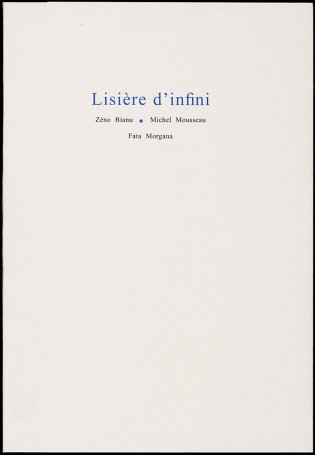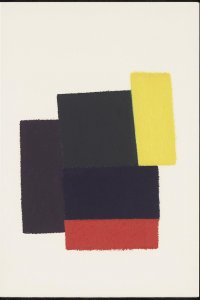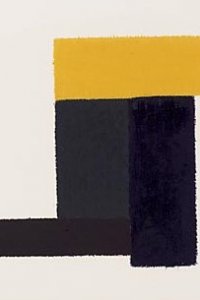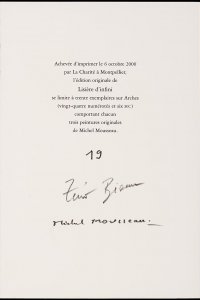Lisière d'infini
Year: 2000
Author: Zéno Bianu (*1950)
Artist: Michel Mousseau (*1934)
Publisher: Fata Morgana
To the happy few
The typical Fata Morgana publication was published in the series ‘To the happy few’. The edition run was small (30) and, as with many Fata Morgana books, the typography was restrained: all the texts are centred, only one supplementary colour (blue) was used and then only on the cover. There is no publishing logo nor have any formal details, such as typeface, series title or ISBN been given so that all attention is channelled towards the texts and the images.
The paintings - abstract compositions with adjoining patches of colour in blue, grey, yellow, red and black oil paint – differ in each copy. Despite the presence of the isolating varnish, the paint was so thoroughly absorbed by the Arches paper that the compositions became visible on the reverse side. Hence the reason that Mousseau counter painted the reverse side in black.
Bookbinding
To bookbinder Berdien van Lieshout, the black panes would inspire the binding design she produced in 2008 in which she distinguishes the panes through her use of different materials. The colours do return in this design though, as Van Lieshout painted the sides of the black pieces in the original colours (blue, red and yellow).
Bibliographical description
Description: Lisière d'infini / Zéno Bianu ; [peintures originales de] Michel Mousseau. – Saint-Clément-la-Rivière : Fata Morgana, 2000. - [17] p. : ill. ; 29 cm
Printer: La Charité (Montpellier)
Edition: 30 copies
This copy: Number 19 of 30 on Arches
Note: Signed by the author and the artist.
Bookbinder: Berdien van Lieshout (2008)
Bibliography: Bénézit 9-916
Shelfmark: KW Koopm K 334
References
- Paul van Capelleveen, 'Fata Morgana, Bruno Roy & David Massabuau', in: Artists & others. The imaginative French book in the 21st century. Koopman Collection, National Library of the Netherlands. Nijmegen, Vantilt Publishers, 2016, p. 139-144.
- Paul van Capelleveen, Sophie Ham, Jordy Joubij, Voices and visions. The Koopman Collection and the Art of the French Book. The Hague, Koninklijke Bibliotheek, National Library of the Netherlands; Zwolle, Waanders, 2009
- Paul van Capelleveen, Sophie Ham, Jordy Joubij, Voix et visions. La Collection Koopman et l'Art du Livre français. La Haye, Koninklijke Bibliotheek, Bibliothèque nationale des Pays-Bas; Zwolle, Waanders, 2009



